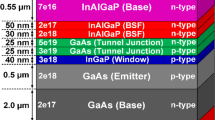Abstract
An effective BSF is a key structural element for an efficient solar cell, either in a multi-junction or in a single-junction device. In this paper, two important materials AlGaAs and InAlGaP with their varied thickness (i.e. 0.05–1.0) μm both for top BSF and bottom BSF cells are investigated using the computational numerical modeling TCAD tool Silvaco ATLAS. It has been found that under the current matching condition with the relatively thinner (30 nm) top BSF layer and the thicker (1,000 nm) bottom BSF layer, the cell exhibit an overall enhancement of short-circuit current density Jsc and open circuit voltage Voc thereby improving the overall efficiency of the cell. A wide band gap material In0.5(Al0.7 Ga0.3)0.5P is proved to be a better choice for both window and BSF layer by increasing 6.2% more efficiency than using other widely used Al0.7 Ga0.3 As material under the same cell configuration because of its high photo generation rate. For this optimized cell structure, the maximum Jsc = 16.10 mA/cm2, Voc = 2.392V, and fill factor = 87.52% are obtained under AM1.5G illumination, exhibiting a maximum conversion efficiency of 32.1964% (1 sun) and 36.6781% (1,000 suns). This work reports the Influence of different BSF material and structures on the characteristics and efficiency of Multi-Junction solar cells. The detail photo-generation rates and EQE in this optimized ARC less DJ solar cell structure are also observed. The major stages of the modeling are explained and the simulation results are validated with published experimental data to demonstrate the accuracy of our results produced by the model utilizing this technique.
Similar content being viewed by others
References
Adachi S., Kato H., Moki A., Ohtsuka K.: Refractive index of (AlxGa1-x)0.5In0.5P quaternary alloys. J. Appl. Phys. 75(1), 478–480 (1994)
Aspnes D.E., Kelso S.M., Logan R.A., Bhat R.: Optical properties of AlxGa1-xAs alloy of same band-gap. J. Appl. Phys. 60(2), 754–767 (1986)
Burnett, B.: The basic physics and design of III–V multijunction solar cells. Available: http://photochemistry.epfl.ch/EDEY/III-V_physics.pdf [Accessed May. 18, 2010] (2002)
Cavicchi, B., Krut, D., Lillington, D., Kurtz, S., Olson, J.: Design and evaluation of dual-junction GaInP/GaAs solar cells for space. In: 22nd IEEE PVSC, pp. 63–67 (1991)
Geisz J.F., Friedman D.J., Ward J.S., Duda A., Olavarria W.J., Moriarty T.E., Kiehl J.T., Romero M.J., Norman A.G., Jones K.M.: 40.8% Efficient inverted triple-junction solar cell with two independently metamorphic junctions. Appl. Phys. Lett. 93(123505), 1–3 (2008)
Green M.A.: Solar cell fill factors: general graph and empirical expressions. Solid-State Electron. 24(8), 788–789 (1981)
Hutchby, J.A., Markunas, R.J., Bedair, S.M.: Material aspects of the fabrication of multijunction solar cells. In: Proceedings of the 14th Critical Reviews of Technology Conference. Arlington, VA, pp. 40–61 (1985)
Karam N.H. et al.: Development and characterization of high-efficiency Ga/sub 0.5/In/sub 0.5/P/GaAs/Ge dual- and triple-junction solar cells. IEEE Trans. Electron Devices 46(10), 2116–2125 (1999)
Kato H., Adachi S., Nakanish H., Ohtsuka K.: Optical properties of (AlxGa1-x) 0.5In0.5P quaternary alloys. Jpn. J. Appl. Phys. 33(1), 186–192 (1994)
King, R.R., Karam, N.H., Ermer, J.H., Haddad, N., Colter, P., Isshiki, T., Yoon, H., Cotal, H.L., Joslin, D.E., Krut, D.D., Sudharsanan, R., Edmondson, K., Cavicchi, B.T., Lillington, D.R.: Next generation, high-efficiency III–V multi-junction solar cells. In: Photovoltaic Specialists Conference. Conference Record of the 28th IEEE, pp. 998–1001 (2000)
Lee H.-Y., Lee C.-T.: The investigation for various treatments of InAlGaP Schottky diodes. In: Proceedings of the 8th international conference on electronic materials. IUMRS-ICEM 23(1–2), 99–102 (2002)
Leem J.W., Lee Y.T., Yu J.S.: Optimum design of InGaP/GaAs dual-junction solar cells with different tunnel diodes. Opt. Quantum Electron. 41(8), 605–612 (2010)
Lillington, D., Cotal, H., Ermer, J., Friedman, D., Moriarty, T., Duda, A.: A 32.3% efficient triple junction GaInP/sub 2//GaAs/Ge concentrator solar cells. In: Energy Conversion Engineering Conference and Exhibit, 2000. (IECEC) 35th Intersociety, vol. 1, pp. 516–521 (2000)
Lindholm F.A., Fossum J.G., Burgess E.L.: Application of the superposition principle to solar-cell analysis. IEEE Trans. Electron Devices 26(3), 165–171 (1979)
Lueck M.R., Andre C.L., Pitera A.J., Lee M.L., Fitzgerald E.A., Ringel S.A.: Dual junction GaInP/GaAs solar cells grown on metamorphic SiGe/Si substrates with high open circuit voltage. IEEE Electron. Device Lett. 27(3), 142–144 (2006)
Lundstrom M., Shuelke R.: Numerical analysis of heterostructure semiconductor devices. IEEE Trans. Electron Devices 30, 1151–1159 (1983)
Mandelkorn, J., Lamneck, J. H. Jr.: Simplified fabrication of back surface electric field silicon cells and novel characteristic of such cells. In: Conference on Rec. 9th IEEE Photovoltaic Spec. Conference, p. 66. IEEE, New York (1972)
Morrison R.E.: Reflectivity and optical constants of indium arsenide, indium antimonide, and gallium arsenide. Phys. Rev. 124(5), 1314–1317 (1961)
NREL’s Renewable Resource Data Center. http://rredc.nrel.gov/solar/spectra (2010)
Sato S., Miyamoto H., Imaizumi M., Shimazaki K., Morioka C., Kawano K., Ohshima T.: Degradation modeling of InGaP/GaAs/Ge triple-junction solar cells irradiated with various-energy protons. Solar Energy Mater. Sol. Cells 93(6–7), 768–773 (2009)
SILVACO Data Systems Inc.: Silvaco ATLAS User’s Manual (2009)
SOPRA. http://www.sopra-sa.com. Accessed on 15 june 2010 (2009)
Sze S.M.: Physics of semiconductor devices, 2nd edn. Wiley 811(812), 811–812 (1981)
Vurgaftman I., Meyer J.R., Ram-Mohan L.R.: Band parameters for III–V semiconductors and their alloys. J. Appl. Phys. 89(11), 5815–5875 (2001)
Wojtczuk, S.J., Vernon, S.M., Michael, M.: Sanfacon “COMPARISON OF WINDOWS FOR P-ON-N InGaP SOLAR CELLS” IEEE, pp. 655–658 (1993)
Author information
Authors and Affiliations
Corresponding author
Rights and permissions
About this article
Cite this article
Singh, K.J., Sarkar, S.K. Highly efficient ARC less InGaP/GaAs DJ solar cell numerical modeling using optimized InAlGaP BSF layers. Opt Quant Electron 43, 1–21 (2012). https://doi.org/10.1007/s11082-011-9499-y
Received:
Accepted:
Published:
Issue Date:
DOI: https://doi.org/10.1007/s11082-011-9499-y




